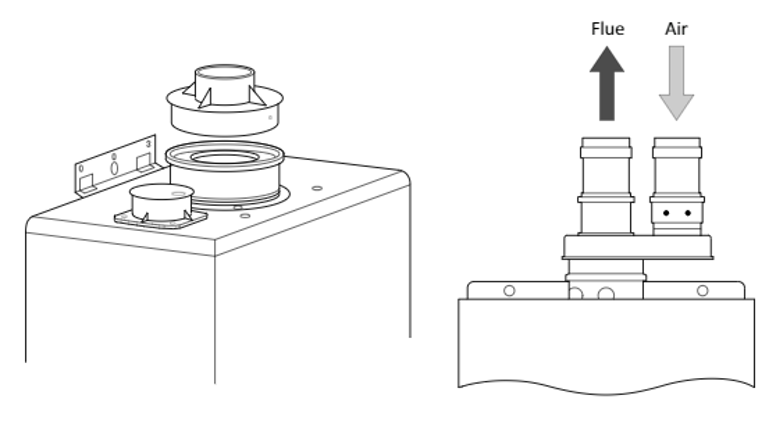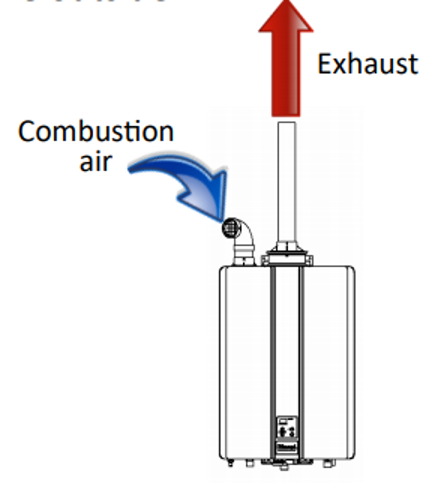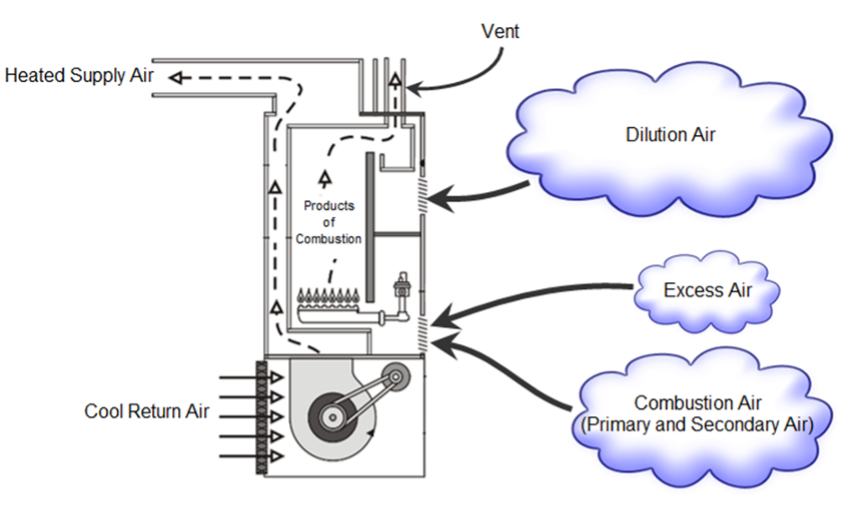Competency B4: Install Air Supply Systems for Fuel Gas Appliances
Learning Task 1
Describe The Methods of Providing Gas Appliance Air Supply
Air consumed by any fuel burning appliances must considered in order to maintain a balanced building. The efficient and safe operation of gas-fired appliances relies on an adequate supply of air over and above that required for building ventilation or make-up air. For all gas appliances, the source environment of the air supply is critical. Combustion air must be free of corrosive chemicals and excessive local atmospheric pressure fluctuations.
There are two common methods of delivering the air supply requirement to a gas appliance:
- direct vent systems
- room air systems (non-direct vent)
Direct vent systems
For a direct vent system all of the air for the appliance is taken directly from the outside as well as the flue gas is discharge to outdoors. Therefore, direct vent appliance will have no effect on the air balance of the building. Direct vent systems typically have two piping options either concentric coaxial pipe or twin pipe (Figure 1).

There are a variety of materials that are used for the venting and air supply piping on direct vent appliances. Some direct vent appliances are designed to use either concentric or twin pipe direct vent options, with the use of the manufacture supplied starter adapter (Figure 2).

Direct vent appliances air supply and exhaust piping system must be sized and installed according to the manufacturer literature and therefore, are not sized by the requirements of the B149.1 Gas code.
Regardless of the category type, if an appliance utilizes indoor combustion air it is not considered a direct vent appliance. For example some direct vent appliances may also be installed as room air dependent systems (Figure 3), in this case the room air supply needs to conform to the manufacturer’s instructions as well as to the gas code.

Room air systems
Non-direct vent gas appliances draw all of their air supply requirements from the internal room air. The amount of air required will depend on the type of appliance(s) in the room. If an appliance is a natural draft appliance designed to operate with a draft control device, it will require a larger volume of air supply than equipment designed to operate with no draft control device, based on the dilution air requirement (Figure 4).

If adequate outside air Is not supplied to the room it will create a negative pressure in the room which will affect the safe operation of the appliances. Depressurization in a building with spillage-susceptible appliances must be limited to −0.02 inch w.c. (−5 Pa). The outside air is normally brought close to the gas appliance burners via a duct (Figure 5), but a hole in the wall may be used in some instances.

The size and location of the duct will be determined by a number of factors including:
- the input of the appliances (Btu/h)
- type of appliances (draft control device or not)
- building construction
Some loosely constructed buildings with adequate air infiltration and large enough volume, such as a warehouse, may not require an outside opening. In these cases, as the air supply can be provided directly from within the structure with no need for ducts or openings. Even in these instances, the indoor air supply may not be suitable if excessive dust or a corrosive atmospheric condition exists.
These methods of using a duct or opening to outside could be referred to as passive air supply compared to a mechanical air supply such as a fan. If a mechanical air supply is used it must be properly sized and interlocked with the appliances to shut-off the gas in the event of an air supply failure. This type of system will require that the gas be reactivated by a manual reset control so that corrective measures are taken by the service technician before the appliance is operated again.
 Now complete Self-Test 1 and check your answers.
Now complete Self-Test 1 and check your answers.
Self-Test 1
Self-Test 1
Media Attributions
- Figure 1. “Direct vent appliances” from Rinnai is used for educational purposes under the basis of fair dealing.
- Figure 2. “Direct vent starter adapters” – The source for this image is unknown. It is being used for non-commercial, educational purposes. To receive credit for this image, please reach out to the publisher.
- Figure 3. “Room air dependant direct vent appliance” from Rinnai is used for educational purposes under the basis of fair dealing.
- Figure 4. “Room air requirements” – The source for this image is unknown. It is being used for non-commercial, educational purposes. To receive credit for this image, please reach out to the publisher.
- Figure 5. “Ducted gas appliance air supply” – The source for this image is unknown. It is being used for non-commercial, educational purposes. To receive credit for this image, please reach out to the publisher.

